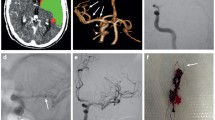Abstract
Background
Endovascular thrombectomy has been proven effective in the first 6 h after onset of stroke and large-vessel occlusion in the anterior cerebral circulation. To date, it was not clear whether thrombectomy beyond 6 h is also beneficial.
Methods
A summary of the prospective DAWN (DWI or CTP Assessment with Clinical Mismatch in the Triage of Wake-Up and Late Presenting Strokes Undergoing Neurointervention with Trevo) and DEFUSE-3 (Endovascular Therapy Following Imaging Evaluation for Ischemic Stroke) trials is presented.
Results
The DAWN and DEFUSE-3 trials showed the efficacy of thrombectomy in selected patients with occlusion of proximal vessels in the anterior circulation up to 24 h after suspected onset of symptoms.
Conclusion
Thrombectomy was shown to have high efficacy up to 24 h after suspected symptom onset; however, patient selection is very complex. Early detection of large-vessel occlusion is of utmost importance. The cooperation between existing neurovascular networks should be adapted according to these new findings.
Zusammenfassung
Hintergrund
Innerhalb der ersten 6 h nach Beginn eines Schlaganfalls wurde die Effektivität der endovaskulären Thrombektomie für proximale Gefäßverschlüsse im vorderen zerebralen Stromgebiet in mehreren Studien nachgewiesen. Es war bisher unklar, ob die Thrombektomie auch jenseits dieser Zeit von Nutzen ist.
Methode
Die kürzlich präsentierten Daten der prospektiven DAWN- (DWI or CTP Assessment with Clinical Mismatch in the Triage of Wake-Up and Late Presenting Strokes Undergoing Neurointervention with Trevo) und der DEFUSE-3-Studie (Endovascular Therapy Following Imaging Evaluation for Ischemic Stroke) , die den Nutzen der Thrombektomie bei selektierten Patienten mit Verschlüssen proximaler anteriorer Hirngefäße bis zu 24 h nach mutmaßlichem Beginn der Symptomatik zeigten, werden zusammengefasst.
Schlussfolgerung
Bei einer selektierten Gruppe von Patienten wurde die Effizienz einer endovaskulären Thrombektomie bis zu 24 h nach mutmaßlichem Symptombeginn gezeigt. Allerdings ist die Indikationsstellung komplex. Weiterhin gilt, dass bei Patienten mit schwerem Schlaganfall sehr frühzeitig eine intrakranielle Gefäßdarstellung erfolgen muss, damit eine rasche Diagnostik und Therapie ohne Verzögerung durchgeführt werden kann. Die Kooperation existierender neurovaskulärer Netzwerke muss an die Ergebnisse dieser beiden Studien angepasst werden.
Similar content being viewed by others
References
Albers GW, Marks MP, Kemp S, Christensen S et al (2018) Thrombectomy for stroke at 6 to 16 hours with selection by perfusion imaging. N Engl J Med 378(8):708–718
Austein F, Riedel C, Kerby T, Meyne J, Binder A, Lindner T, Huhndorf M, Wodarg F, Jansen O (2016) Comparison of perfusion CT software to predict the final infarct volume after thrombectomy. Stroke 47(9):2311–2317
Berkhemer OA, Fransen PS, Beumer D, van den Berg LA, Lingsma HF et al (2015) A randomized trial of intraarterial treatment for acute ischemic stroke. N Engl J Med 372(1):11–20
Bracard S, Ducrocq X, Mas JL, Soudant M et al (2016) Mechanical thrombectomy after intravenous alteplase versus alteplase alone after stroke (THRACE): a randomised controlled trial. Lancet Neurol 15(11):1138–1147
Campbell BC, Mitchell PJ, Kleinig TJ, Dewey HM et al (2015) Endovascular therapy for ischemic stroke with perfusion-imaging selection. N Engl J Med 372(11):1009–1018
Froehler MT, Saver JL, Zaidat OO, Jahan R et al (2017) Interhospital transfer before thrombectomy is associated with delayed treatment and worse outcome in the STRATIS registry (systematic evaluation of patients treated with Neurothrombectomy devices for acute Ischemic stroke). Circulation 136:2311–2321
Goyal M, Demchuk AM, Menon BK, Eesa M et al (2015) Randomized assessment of rapid endovascular treatment of ischemic stroke. N Engl J Med 372(11):1019–1030
Goyal M, Menon BK, van Zwam WH, Dippel DW et al (2016) Endovascular thrombectomy after large-vessel ischaemic stroke: a meta-analysis of individual patient data from five randomised trials. Lancet 387(10029):1723–1731
Jovin TG, Liebeskind DS, Gupta R, Rymer M (2011) Imaging-based endovascular therapy for acute ischemic stroke due to proximal intracranial anterior circulation occlusion treated beyond 8 hours from time last seen well: retrospective multicenter analysis of 237 consecutive patients. Stroke 42(8):2206–2211
Jovin TG, Chamorro A, Cobo E, de Miquel MA et al (2015) Thrombectomy within 8 hours after symptom onset in ischemic stroke. N Engl J Med 372(24):2296–2306
Lansberg MG, Cereda CW, Mlynash M, Mishra NK et al (2015) Response to endovascular reperfusion is not time-dependent in patients with salvageable tissue. Neurology 85(8):708–714
Nogueira RG, Jadhav AP, Haussen DC, Bonafe A (2018) Thrombectomy 6 to 24 Hours after Stroke with a Mismatch between Deficit and Infarct. N Engl J Med 378(1):11–21
Noorian AR, Sanossian N, Shkirkova K, Liebeskind DS et al (2018) Los Angeles motor scale to identify large vessel occlusion: prehospital validation and comparison with other screens. Stroke. https://doi.org/10.1161/STROKEAHA.117.019228
Ragoschke-Schumm A, Yilmaz U, Kostopoulos P, Lesmeister M et al (2015) “Stroke room”: diagnosis and treatment at a single location for rapid Intraarterial stroke treatment. Cerebrovasc Dis 40(5–6):251–257
Saver JL, Goyal M, van der Lugt et al (2016) Time to Treatment With Endovascular Thrombectomy and Outcomes From Ischemic Stroke: A Meta-analysis. JAMA 316(12):1279–1288
Saver JL, Goyal M, Bonafe A, Diener HC et al (2015) Stent-retriever thrombectomy after intravenous t‑PA vs. t‑PA alone in stroke. N Engl J Med 372(24):2285–2295
Walter S, Kostopoulos P, Haass A, Keller I et al (2012) Diagnosis and treatment of patients with stroke in a mobile stroke unit versus in hospital: a randomised controlled trial. Lancet Neurol 11(5):397–404
Author information
Authors and Affiliations
Corresponding author
Ethics declarations
Conflict of interest
A. Ragoschke-Schumm and S. Walter declare that they have no competing interests.
This article does not contain any studies with human participants or animals performed by any of the authors.
The supplement containing this article is not sponsored by industry.
Rights and permissions
About this article
Cite this article
Ragoschke-Schumm, A., Walter, S. DAWN and DEFUSE-3 trials: is time still important?. Radiologe 58 (Suppl 1), 20–23 (2018). https://doi.org/10.1007/s00117-018-0406-4
Published:
Issue Date:
DOI: https://doi.org/10.1007/s00117-018-0406-4




